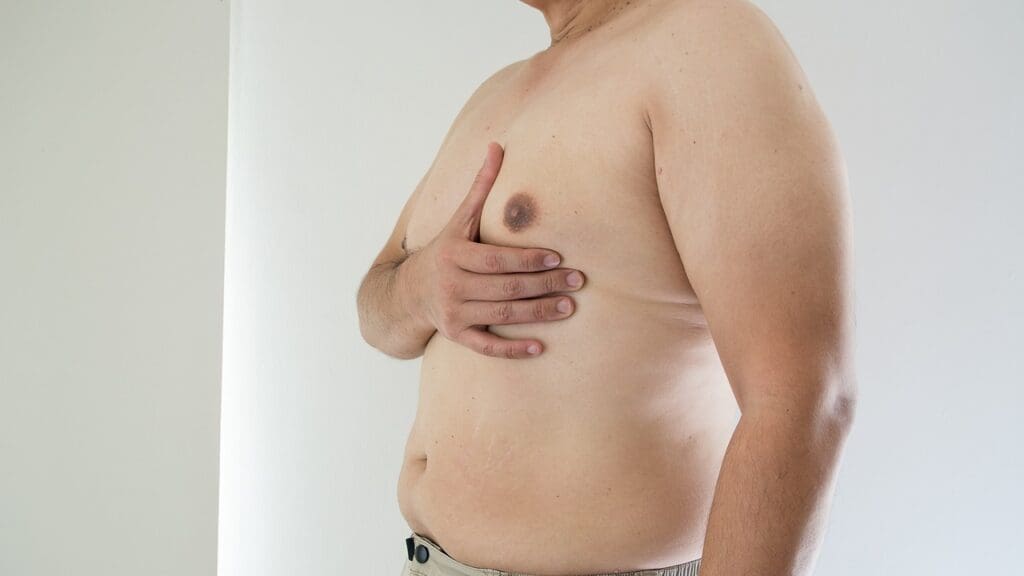Gynecomastia is the enlargement of breast tissue in men, typically affecting both breasts, and is caused by an imbalance between the hormones estrogen and testosterone. While it can occur for a variety of reasons, hormonal changes are the most frequent underlying cause and can affect men of any age. Today, gynecomastia can be effectively treated with medication or surgery, depending on the severity and underlying cause.

What Causes Gynecomastia?
The answer to the question "Why does male breast enlargement occur? is usually due to the decrease in the hormone testosterone compared to the estrogen levels of a man. A decrease in testosterone levels can develop due to conditions that reduce testosterone or increase estrogen levels.
The hormones testosterone and estrogen are hormones that control sex characteristics in both men and women. Testosterone controls male characteristics such as muscle mass and body hair, while estrogen controls various female characteristics such as breast growth. Although estrogen is considered a female hormone, it is also found in a certain amount in men. Imbalances between these two hormones can develop due to different conditions in each age group. The causes of male breast enlargement include medication use, and drug or alcohol use, which trigger hormone levels, especially natural hormone changes. In addition, health conditions such as hypogonadism, aging and tumor development in the body can also cause the development of gynecomastia by creating hormonal imbalances.
What is the Treatment for Gynecomastia?
When male breast enlargement is diagnosed in men, treatment focuses on the underlying cause. If hormonal imbalance is responsible, initial treatment usually involves medications to restore hormonal balance. For persistent or more severe cases, surgical removal of the excess breast tissue may be recommended to achieve the best results.
How is Gynecomastia Noticed?
Male breast enlargement is typically recognized by visible enlargement of breast tissue in men, even if they are not overweight. This physical change is often the first sign. Additional symptoms, such as tenderness or sensitivity around the nipple, can also indicate the presence of gynecomastia.
How Does Male Breast Enlargement Go Away?
When male breast enlargement develops in infants or adolescents due to temporary hormonal changes, it often resolves on its own without treatment. However, in adults, gynecomastia is usually persistent and typically requires medical intervention”either medication to address hormonal imbalances or surgery to remove the excess breast tissue.
What are the Symptoms of Gynecomastia?
Male breast enlargement is often identified through visible physical changes, such as the enlargement of breast tissue in men. While some may not notice any additional symptoms, others may experience signs such as pain, swelling, breast tenderness, or discomfort when the nipple area rubs against clothing.
Pain around the chest
Swelling in breast tissue
Tenderness in the breasts
A feeling of discomfort when the nipple rubs the clothes
Who Gets Gynecomastia?
The disease can affect men at any age. It's sometimes seen in newborns due to maternal estrogen, can develop again during adolescence due to hormonal changes, and may occur in adulthood as a result of aging, weight gain, or certain medications. Other risk factors include the use of anabolic steroids for athletic performance and medical conditions affecting the liver, kidneys, or thyroid. Understanding these risk factors can help with early detection and appropriate treatment.
What is a Male Breast Enlargement Corset?
A male breast enlargement corset (or compression garment) is commonly worn after male breast enlargement surgery. Its main purpose is to help the skin retract, reduce swelling, and support healing. For optimal results, wearing the corset as recommended”typically for the first 4 weeks after surgery”is advised.
Can Male Breast Enlargement Be Corrected with a Corset?
A corset cannot correct this disease. Its role is to support healing and minimize swelling after surgery, helping you achieve the best results by speeding up recovery”not as a standalone treatment for the condition.
Is Gynecomastia Surgery Risky?
Male breast enlargement surgery is generally considered safe, and most patients experience a smooth recovery. However, as with any surgical procedure, some risks exist. Potential complications may include bruising, bleeding, fluid accumulation in the breast tissue, loss of nipple skin, and visible scarring. Your doctor will discuss these risks and ways to minimize them before surgery.
Things to Be Considered After Gynecomastia Surgery
After male breast enlargement surgery, wearing a corset (compression garment) as advised by your doctor is crucial”typically for the first 4 weeks”to support healing and minimize swelling. Patients should rest for the first 1“2 days post-operation and avoid strenuous activities during the initial two weeks. Light cardio and lower body exercises can usually be resumed after two weeks, while chest exercises should be delayed until at least 4 weeks after surgery. In some cases, your doctor may recommend gentle breast massage to support safe recovery.
The Healing Process After Gynecomastia Surgery
Recovery time after male breast enlargement surgery depends on the surgical technique and how much tissue is removed. In most cases, patients fully recover within 4 to 6 weeks.
The Price of Gynecomastia Surgery
The cost of male breast enlargement surgery can vary depending on the hospital and its current pricing policies. For accurate and up-to-date price information, it's best to contact the patient representatives of your chosen healthcare facility directly.
* Liv Hospital Editorial Board has contributed to the publication of this content .
* Contents of this page is for informational purposes only. Please consult your doctor for diagnosis and treatment. The content of this page does not include information on medicinal health care at Liv Hospital .
For more information about our academic and training initiatives, visit Liv Hospital Academy
Frequently Asked Questions
What is gynecomastia?
Gynecomastia is the enlargement of breast tissue in men caused by a hormonal imbalance between estrogen and testosterone, often affecting both breasts.
What causes gynecomastia?
It can result from hormonal changes, certain medications, alcohol or drug use, obesity, or medical conditions such as hypogonadism and thyroid disorders.
What are the symptoms of gynecomastia?
Common signs include swollen breast tissue, tenderness, mild pain, or discomfort when the chest rubs against clothing.
How is gynecomastia treated?
Mild cases caused by temporary hormonal shifts may resolve naturally. Persistent cases may require medication or surgery to remove excess tissue.
Is gynecomastia surgery safe?
Yes. It is generally safe when performed by experienced surgeons. Possible risks include minor bruising, swelling, or scarring, which usually heal with proper care.
What should be done after surgery?
Wear a compression garment for at least 4 weeks, avoid strenuous activity, and follow your doctor’s post-operative care instructions for faster recovery.
Why choose Liv Hospital for gynecomastia surgery in Turkey?
Liv Hospital offers expert plastic surgeons, modern facilities, and personalized care to ensure safe procedures and natural, confidence-boosting results.
